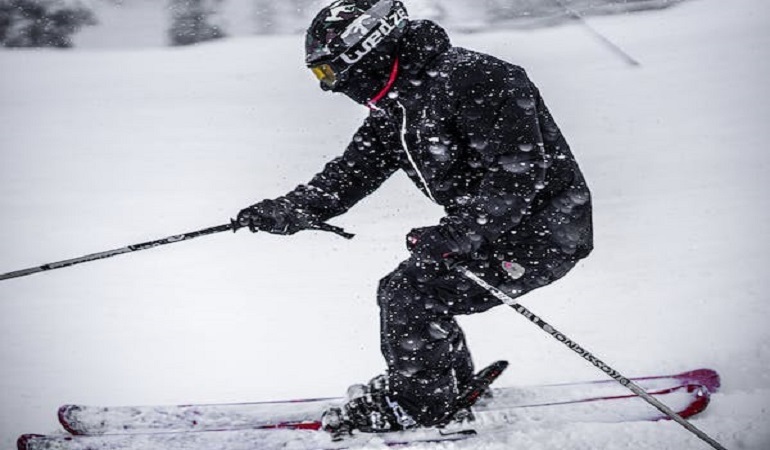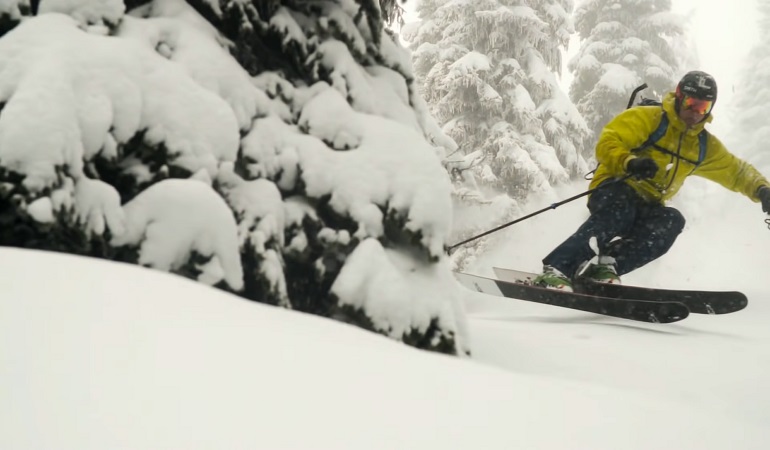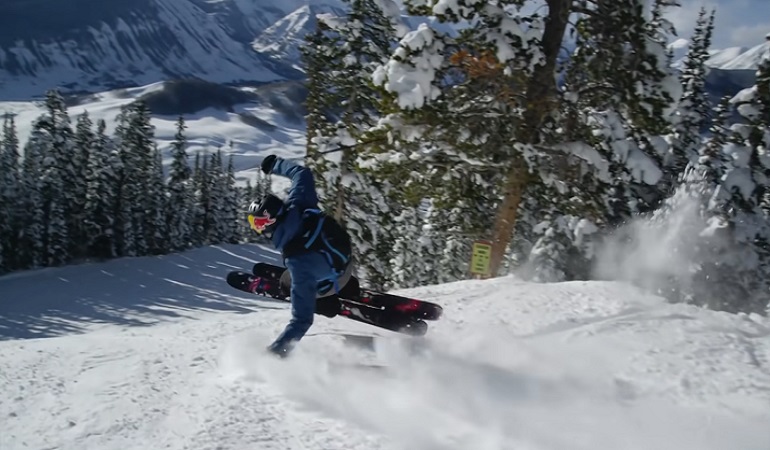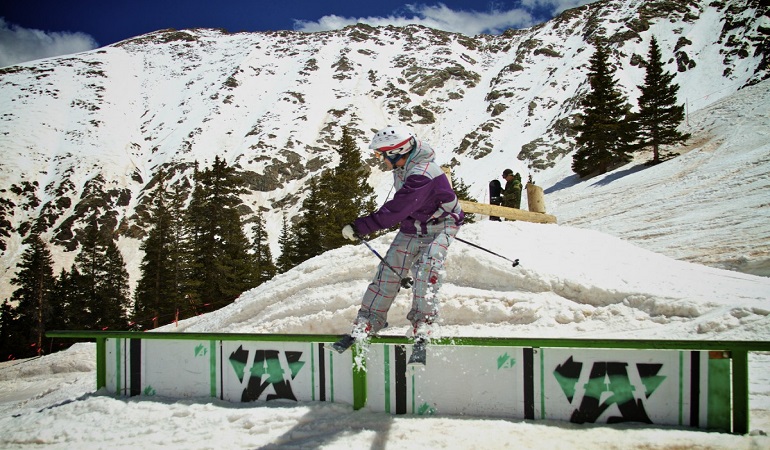If you are new to the world of skiing, which is a vast dimension in itself, you would rightfully be confused by complex terminology. The words rocker, camber, etc., are thrown around, along with phrases like early rise, deep powder, full rocker, and much more.
Ski rocker and ski camber are simple terms that refer to the way your ski looks, and is designed when you look at it from the side. So essentially, you would have ski camber profiles and rocker profiles, or any number of combinations of the two types!
Back in the early 2000s, only a few ski designs were rockered skis. The rest were almost all camber skis!
However, in 2023, we can see the variety of ski designs has grown exponentially. This shows just how much rocker technology has evolved. Let’s look at camber and rocker skis in more detail, with some examples and benefits!
What Is Ski Rocker?

A rocker simply refers to a ski profile that has a flat surface, especially in the midsection of the ski but angles upwards toward the tip and tail of the ski. This angling and bending literally allow the ski to rock back and forth at the tip and tail.
Rocker skis are great for beginners, as rockered skis function best at low speeds. They also function beautifully for powder skiing, which refers to soft snow that is fresh and laid upon deep snow and hard snow.
This allows skis with a rockered tip to be able to have a superior float mechanism over the snow and glide you along it without the need for too much technique and control. This also means that you can control the ski better if you are just an amateur at skiing.
What Does Rocker Do?
First and foremost, the tip and tail rocker helps in keeping you above the snow. If you put your skis down on the snow and find that the two ends of the ski, the tip (the head or front) and the tail (the back) are bending upwards away from the snow, you definitely have a full-rocker ski on your hands.
Bottomless powder refers to an ideal skiing scenario, where rocker options would be extremely useful. It would be a super soft snow cushion, where turning and maneuvering would be quite easy, and would require less technique. Rockered skis would be great to use here as they would keep you from sinking in the snow.
Skis with a tip rocker would have a short effective edge. The effective edge refers to the distance between the contact points where the ski touches the ground, and if it’s short, then maneuvering quickly and making turns on snow would be easy, as your edge control and edge grip would be decreased.
It’s a fun experience for beginners to learn how to ski!
Types of Rockers
Following are the different types of rockers:
1. CAMBER

Early ski technology evolved from the traditional camber ski. Cambered ski designs refer to camber underfoot. This means that the skis have an arched center, so the midsection of the ski rests above the snow when you lay it on a flat surface or on the snow.
When pressed, the cambered center would bounce back. This curving or arching is a ski camber, and ski manufacturers have built modern skis of traditional ski camber profiles.
With a much longer effective edge length, camber skis are used on more packed snow and icy slopes. Usually, camber and full camber skis are used specifically by advanced and intermediate skiers who use high speeds and have a terrain preference for hardpack snow and groomed slopes.
This is because a lot more technique and practice are needed to maintain a better edge grip and edge control for making sharp turns than casual ski and powder skis. You can boost your turning and carving ski by sharpening your ski edges properly.
More camber in your ski equals more power. Camber is precise to allow for snappy transition movements. Thus, unless you practice at proper ski schools, it will feel like the ski is using you!
2. ROCKER

Ski rocker, sometimes called reverse camber, is essentially a camber turned upside down, which means it would lay flat in the middle and turn up towards the tip and tail.
There are normal reverse camber ski types, and then there is early rise. These styles allow up to a 40% point at the tip and tail of the ski to rise upwards, making for a very small effective edge length, and a lot of easy movement.
Rockers basically do the work for you! Easy movement means that the skis can maintain themselves without you exerting too much pressure, so ensuring stress-free skiing indeed.
3. CAMBER- ROCKER
Most skis are built nowadays with some combination of ski camber and rocker technology. Ski manufacturers focus on creating a balance between rocker and camber types, to suit the various needs of different players.
For example, ski racers would want a high-precision ski, so they would suit a camber with a tip rocker curve for easy turning but a grounded center. But good camber-rocker styles offer a good middle point in skiing, and are suitable for all, from beginners to advanced levels.
Benefits of Rockers
1. Rocker in the Terrain Park

Research and interviews have proven that skiers enjoy going to the terrain park with flat rocker-type skis more than cambered ones. The word “playful” is used to describe the rocker types, and that refers to the flex pattern of a ski, which should be ideally less powerful and easy to let go of when turning and jumping.
So, rocker-type skis are great to use in parks to perform tricks. This is because of the smaller effective edge length, which allows for lesser pressure exerted on land. This makes it easier to perform jumps on rails and tricks than skis with camber profiles.
2. Rocker Offers Increased Float in the Powder
If you are a fan of the good old powder ski, then nothing will give better stability and control over the deep powder snow landscape than rockers. The flotation ability of the rocker shape and the curve at both the tip and tail help you from sinking into the snow and maintaining a light ski feel.
3. Rocker Is More Maneuverable

The rocker is extremely maneuverable, mostly because of its decreased edge length due to closer contact points, especially if it’s a reverse camber. This means decreased pressure of your feet on the ground and less control exerted.
So of course, maneuvering is super easy! The rocker-style ski allows much more flexibility to move than the camber.
Final Thoughts
What kind of ski profile you want is heavily dependent on the kind of skiing you want to pursue. For light, maneuverable skiing, rockers are best. But camber is always an advantage, as having more precision and control makes you a better skier!
When you go to purchase your ideal skis, keep camber and rocker length in mind, as different ski terrains call for different camber and rocker ratios. The rule of thumb is to get a tail rocker for packed snow, and a camber and tip rocker for all-mountain!
Don’t forget to have fun on the slopes! Happy skiing!
0 Comments